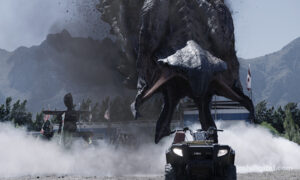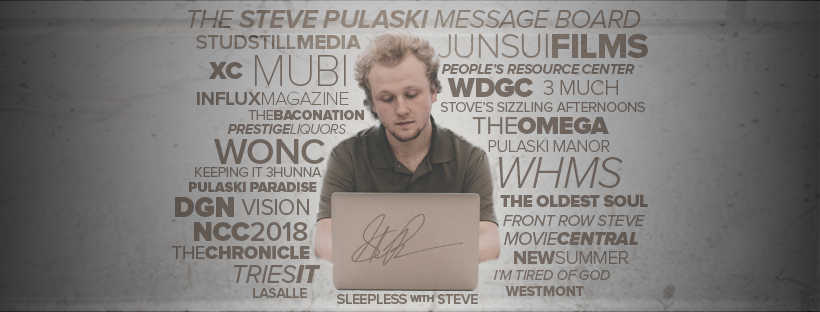Publication Date: 10-31-2025
Tremors: A Cold Day in Hell (2018) review
Dir. Don Michael Paul
By: Steve Pulaski
Rating: ★½
There are desperately few franchises that make it to six films and finally commit a mortal sin or a fatal misstep, so with that in mind, I shouldn’t be so hard on Tremors: A Cold Day in Hell. Coming three years after the last installment in the series and 28 years after the original film hit theaters, Tremors should’ve went downhill a long time ago. Instead, it inspired a great many fans to, in part, demand Universal make more sequels involving Graboids and their many forms. In my early days of navigating the internet, I remember allowing my imagination to run wild while scrambling for information on the then-rumored “Tremors V” film that was said to be called “The Thunder from Down Under.” I could hardly fathom that coming to fruition let alone another film following so closely after. I wonder how ten-year-old-me would’ve responded to this film: would I have even been able to call it a flop?
Tremors: A Cold Day in Hell shows what happens when the heart outpaces the head, and a series comes to terms, perhaps unconsciously, with the fact that it was never conceptualized to have gone this far. That’s the flaw in nearly all sequels and breakout successes, especially one like Tremors, for had it not been for the original outselling every other VHS on the Blockbuster shelf, a host of follow-ups would’ve never materialized. Regarding this sixth installment, it’s practically a disaster on all fronts. With an incompetent script turning the cherished Burt Gummer into a sociopath spewing one-liners, D-grade special effects that do not come close to matching the look of the first two sequels, a pitiful crop of supporting characters, and a misrepresented setting, even the most optimistic fan will be hard-pressed to defend the mess that transpires on-screen.
Like all great Tremors sequels, it revolves around Burt Gummer (Michael Gross, the ol’ reliable of the series), who now spends his days running Chang’s Market and fighting with spineless taxmen who try to nab him for fraud. His son, Travis (Jamie Kennedy, reprising his role from the previous film), returns just as Burt gets a call from a group of scientists who have come across vicious Graboids while stationed in the Canadian arctic. At first in disbelief, Burt is convinced to leave Perfection, yet again, and travel north with his son to investigate. The two learn that rather than Garboids being a species solely belonging to desert locales, they also have “pre-Precambrian” roots as creatures capable of surviving in the tundra. The creatures awakening in Canada was caused by the planet’s rapidly heating temperatures that awoken them from subterranean ice that was once impenetrable.

So Burt, Travis, and a slew of other faces not nearly as memorable as Helen Slater’s, Shawn Christian’s, or Fred Ward’s, for that matter, stowaway in a research facility adjacent to DARPA, whom Burt suggests is responsible for the abrupt appearance of Graboids in an uncommon place. Compounding the expected difficultly in capturing the worms is Burt’s own instability. Apparently many years after being swallowed whole by a Graboid, Burt is now feeling the wrath of the beast’s venom, which prompts many seizure-like spells of paralysis and nausea, the likes of which render him bed-bound and in need of antibodies exclusive to Graboids.
The science behind the Graboids still pleasantly inserts itself as an integral part in the film’s screenplay. Adding on to that, fans will embrace the jokes made about Burt’s new Chicago Cubs hat (as opposed to the white Atlanta Hawks hat that was his staple) as well as the significance of the Valerie character, played by Jamie-Lee Money, which I will dare not spoil. But these assortments of puff cutely positioned in an otherwise deceptive and disingenuous screenplay only give the faintest allusion that we’re watching a classic Tremors film when we’re in fact watching a frustrating deviation from the successful formula.
The film’s script is lackluster, predicated off of exaggerated punchlines and Duke Nukem-like quips that undermine both mood and character-integrity. This problem most adversely effects Burt’s character, who is rendered an unsympathetic narcissist for much of the film, almost without a likable or believable bone in his body. “I suggest you swallow a couple spoonfuls of cement and harden the hell up,” he screams at a character at one point in the film. In another scene, in efforts to give motivation to a meek soul who just had a nearly lethal run-in with an Ass Blaster, Burt grabs him by his head, coach-to-quarterback-style, and makes him exclaim, “My balls are in the ‘Guinness Book of Balls.'” On top of being silly and couching any sense of suspense, these downright stupid lines turn Burt into a caricature with desperately little credibility.

The Graboids themselves look exceptionally poor, and directed by Don Michael Paul, whose filmography includes the Lake Placid: The Final Chapter and the Lifetime ripoff of Taken, they live up to the quality of what could be considered their sister-films. Ass Blasters, along with the retractable tentacles of the larger worms, appear less like past iterations of Graboids and more-like aliens from another planet. Both have more in common with the squirmy, slimy Neomorphs of Alien: Covenant than they do the classic looks of the Graboids, and leave a lot to the imagination given they look less aesthetically believable than the creatures in films that are twenty years this film’s junior.
Despite the marketing relentlessly informing us of the “Graboids in the snow” gimmick this installment was allegedly supposed to capitalize on, anxious fans like myself will be disappointed at the realization that the part in Canada in which Graboids are tracked is going through a “heatwave.” This doesn’t make a lot of sense, for in the opening sequence, we see a plethora of scientists navigating the snowy plains of the country’s most treacherous regions, as well as the first sighting of Graboids who reside in snowpack. How they moved so quickly to a place with not a flake on the ground that more-so resembles Perfection than Canada is beyond me, and frankly, it’s another way this effort underwhelms.
Some franchises peak early and then have the bulk of their sequels kick sand in the face of the original; the Paranormal Activity sequels are a good example of this. The Child’s Play franchise had two laudable efforts before crash-landing with an embarrassing third installment. A Nightmare on Elm Street repeatedly fell down after “getting up,” so to speak, Friday the 13th was a rollercoaster in both quality and timeline, and I’m still not convinced the Leprechaun series is more a collection of mildly amusing moments than a series of seven (soon-to-be eight) full-length films. The fact that Tremors went on this long is amazing. The fact that Tremors: A Cold Day in Hell could be this bad also inspires a bit of disbelief.
NOTE: Take a listen to my interview with Michael Gross, where we talk all things Tremors, how and why Universal revived the series in 2015, and why rights issues makes the future of the franchise murky:
NOTE II: Listen to my discussion of Tremors: A Cold Day in Hell on my radio-show Sleepless with Steve on WONC 89.1FM:
My review of Tremors (1990)
My review of Tremors II: Aftershocks
My review of Tremors 3: Back to Perfection
My review of Tremors 4: The Legend Begins
My review of Tremors 5: Bloodlines
My review of Tremors: Shrieker Island
Starring: Michael Gross, Jamie Kennedy, Jamie-Lee Money, and Tanya van Graan. Directed by: Don Michael Paul.
About Steve Pulaski
Steve Pulaski has been reviewing movies since 2009 for a barrage of different outlets. He graduated North Central College in 2018 and currently works as an on-air radio personality. He also hosts a weekly movie podcast called "Sleepless with Steve," dedicated to film and the film industry, on his YouTube channel. In addition to writing, he's a die-hard Chicago Bears fan and has two cats, appropriately named Siskel and Ebert!


